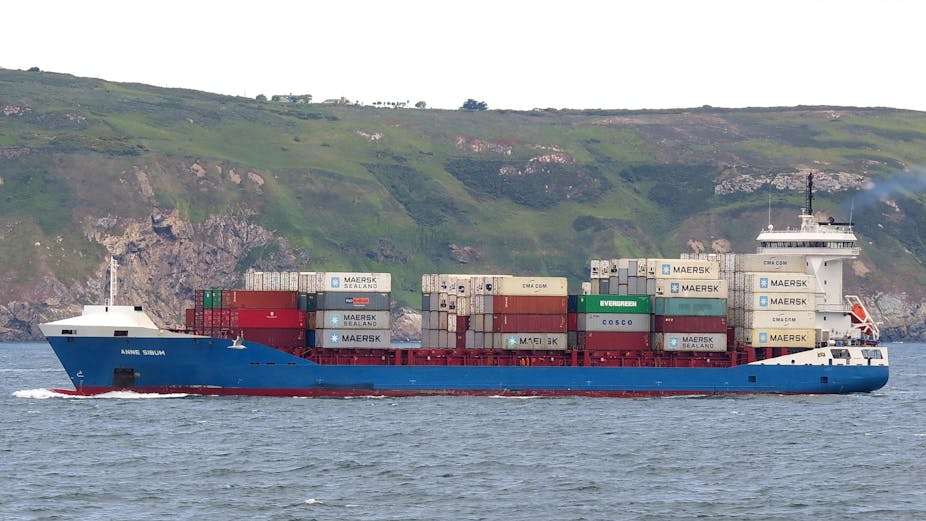Any doubt that the media is in silly season was laid to rest on July 28 when The Times ran a front page headline claiming “The Irish want sea border with UK after Brexit”. The article implied that Brexit could mean Irish unification and unsurprisingly sparked a firm response from the Democratic Unionist Party (DUP) politicians who are shoring up the Conservatives’ small majority in Westminster. They stated their readiness to “block Dublin” in this nefarious plot.
The Times article was based on comments made by the Irish minister for foreign affairs, Simon Coveney, in Brussels the previous week. Yet he had never actually made such a claim – at least not as it was interpreted – and the only change in the Irish government’s position was not in content but in its less than patient tone. Aware of the political sensitivities around the matter, the Irish Taoiseach, Leo Varadkar, was quick to come before the cameras to directly state the position of the Irish government:
It’s the United Kingdom, it’s Britain that has decided to leave and if they want to put forward smart solutions, technological solutions for borders of the future and all of that that’s up to them. We’re not going to be doing that work for them because we don’t think there should be an economic border at all. That is our position.
The somewhat exasperated tenor of the Taoiseach’s comments resonates with that of recent statements from Brussels regarding the progress of Brexit negotiations. That the Irish, the UK’s closest partners in the EU, are expressing such frank frustration – after over a year of cautious tongue-biting – is not a good sign.

A barrier or filter?
There are two fundamental questions to be asked when considering the management of the Irish border as one of the EU’s external borders. The first: which border are we talking about – a border for goods or people? And the second, what are the checks for? The answers to these questions must form the basis of any proposed solution.
It’s possible to have different types of border for different types of movement. Expertise on the management of other borders (both within and beyond the EU) would show that the solutions to such post-Brexit challenges need not centre on a straightforward choice between a land border or a sea border. Unfortunately, the Home Office appears not to have drawn on this kind of expertise yet.
The movement of people is the easiest to manage. The UK and Ireland are not part of the EU’s Schengen Zone of free movement. This means the EU’s external border for entry to its territory is, in effect, already in the English Channel.
Questions of access to work, services and residency, however, will be decided in the negotiations regarding EU citizenship rights after Brexit. The UK and Ireland both need to pass legislation in order to guarantee the rights of Irish and British citizens in their respective territories if these rights are to continue to stand above those of EU citizens. How British and Irish citizens are distinguished from others within the UK after Brexit will entail other procedures that are not found at the physical border. These will be put in place within each country, through “point of contact” controls such as immigration status checks and monitoring by employers, universities, or landlords.
A political solution
The more knotty problem lies in the border acting as a barrier to the movement of goods. Put simply, if the UK leaves the single market and customs union, the Irish border will become a customs barrier between the two. The need to protect citizens and consumers from dangerous, prohibited goods, as well as to enforce customs regulations and duties, means that there will inevitably be friction in the trade across the border.
Technology can help, but it cannot substitute for the inspection of undeclared or inappropriately declared goods in transit across a border. Customs controls cannot be effectively implemented if there is no expectation that proper inspections of goods in transit would ever be performed. What is more, the costs imposed on businesses in order to comply with the new customs regimes and procedures on both sides of the border are likely to rise significantly. At the same time, the incentive for smuggling and illegal trading will shoot through the roof.
If a “frictionless” border is impossible, and an “invisible” border poses as many questions as it answers, Coveney is right to point to the need for a “political solution” before a technological solution can be found. No political solution to a contested border can be found, or imposed, unilaterally.
The 1998 Good Friday Agreement carved the way for defusing the border issue in Ireland. It did so on the grounds that Northern Ireland is not a “place apart” but rather forms a nexus between these two islands, whose histories and futures remain inextricably intertwined. With this in mind, the UK government would be well-advised to make extra efforts to work constructively with the Irish government rather than to risk continuing to aggravate them. As even the DUP’s Nigel Dodds has noted, this is “a time when common sense co-operation between our two countries and between the Republic and Northern Ireland is what’s needed”.

